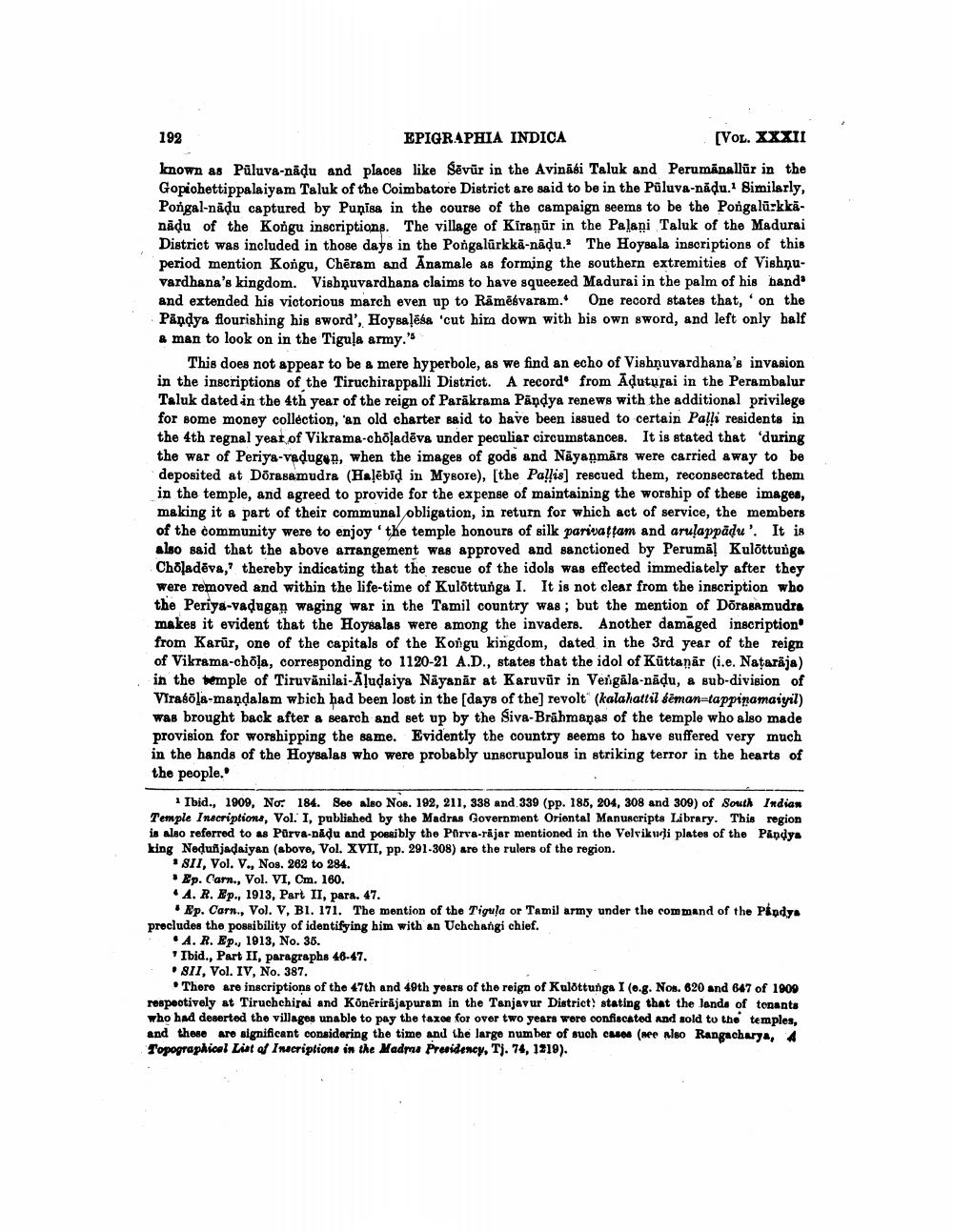________________
EPIGRAPHIA INDICA
[VOL. XXXII known as Piluva-nadu and places like Sevür in the Avinasi Taluk and Perumanallur in the Gopichettippalaiyam Taluk of the Coimbatore District are said to be in the Püluva-nadu.1 Similarly, Pongal-nadu captured by Puņisa in the course of the campaign seems to be the Pongalurkkanadu of the Kongu inscriptions. The village of Kiranür in the Palani Taluk of the Madurai District was included in those days in the Pongalurkka-nāḍu. The Hoysala inscriptions of this period mention Kongu, Cheram and Anamale as forming the southern extremities of Vishnuvardhana's kingdom. Vishnuvardhana claims to have squeezed Madurai in the palm of his hand3 and extended his victorious march even up to Rāmēsvaram. One record states that, on the Pandya flourishing his sword', Hoysalesa 'cut hira down with his own sword, and left only half a man to look on in the Tigula army.'s
192
This does not appear to be a mere hyperbole, as we find an echo of Vishnuvardhana's invasion in the inscriptions of the Tiruchirappalli District. A record from Aduturai in the Perambalur Taluk dated in the 4th year of the reign of Parakrama Pandya renews with the additional privilege for some money collection, an old charter said to have been issued to certain Palli residents in the 4th regnal year of Vikrama-chōladeva under peculiar circumstances. It is stated that 'during the war of Periya-vaḍugen, when the images of gods and Nayanmars were carried away to be deposited at Dōrasamudra (Halebid in Mysore), [the Pallis] rescued them, reconsecrated them in the temple, and agreed to provide for the expense of maintaining the worship of these images, making it a part of their communal obligation, in return for which act of service, the members of the community were to enjoy the temple honours of silk parivaṭṭam and arulappāḍu'. It is also said that the above arrangement was approved and sanctioned by Perumā! Kulottunga Chōladeva, thereby indicating that the rescue of the idols was effected immediately after they were removed and within the life-time of Kulottunga I. It is not clear from the inscription who the Periya-vadugan waging war in the Tamil country was; but the mention of Dōrasamudra makes it evident that the Hoysalas were among the invaders. Another damaged inscription" from Karur, one of the capitals of the Kongu kingdom, dated in the 3rd year of the reign of Vikrama-chōla, corresponding to 1120-21 A.D., states that the idol of Küttaṇār (i.e. Naṭarāja) in the temple of Tiruvanilai-Aludaiya Nayanar at Karuvür in Vengala-nāḍu, a sub-division of Virasola-mandalam which had been lost in the [days of the] revolt (kalahattil seman-tappiņamaiyil) was brought back after a search and set up by the Siva-Brahmanas of the temple who also made provision for worshipping the same. Evidently the country seems to have suffered very much in the hands of the Hoysalas who were probably unscrupulous in striking terror in the hearts of the people.
1 Ibid., 1909, No: 184. See also Nos. 192, 211, 338 and 339 (pp. 185, 204, 308 and 309) of South Indian Temple Inscriptions, Vol. I, published by the Madras Government Oriental Manuscripts Library. This region is also referred to as Pūrva-nādu and possibly the Pârva-rajar mentioned in the Velvikudi plates of the Pandya king Neḍuñjadaiyan (above, Vol. XVII, pp. 291-308) are the rulers of the region.
SII, Vol. V., Nos. 262 to 284.
Ep. Carn., Vol. VI, Cm. 160.
A. R. Ep., 1913, Part II, para. 47.
Ep. Carn., Vol. V, Bl. 171. The mention of the Tigula or Tamil army under the command of the Pandya precludes the possibility of identifying him with an Uchchangi chief.
A. R. Ep., 1913, No. 35.
Ibid., Part II, paragraphs 46-47.
811, Vol. IV, No. 387.
There are inscriptions of the 47th and 49th years of the reign of Kulottunga I (e.g. Nos. 620 and 647 of 1909 respectively at Tiruchchirai and Kōnērirajapuram in the Tanjavur District! stating that the lands of tenants who had deserted the villages unable to pay the taxce for over two years were confiscated and sold to the temples, and these are significant considering the time and the large number of such cases (see also Rangacharya, 4 Topographical List of Inscriptions in the Madras Presidency, Tj. 74, 1219).




